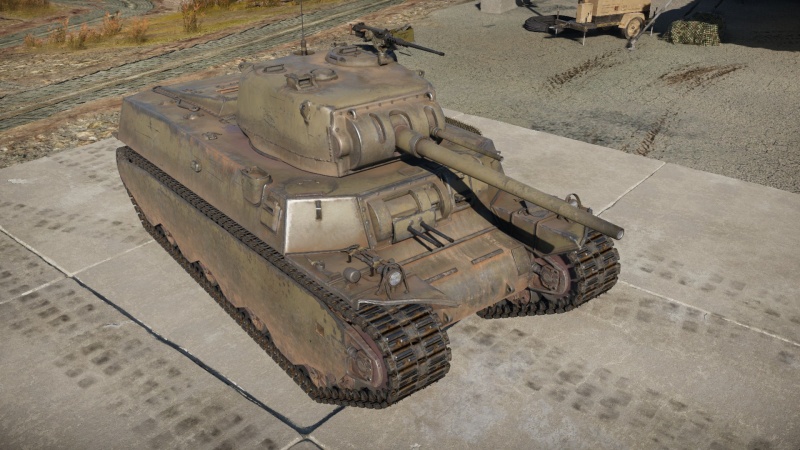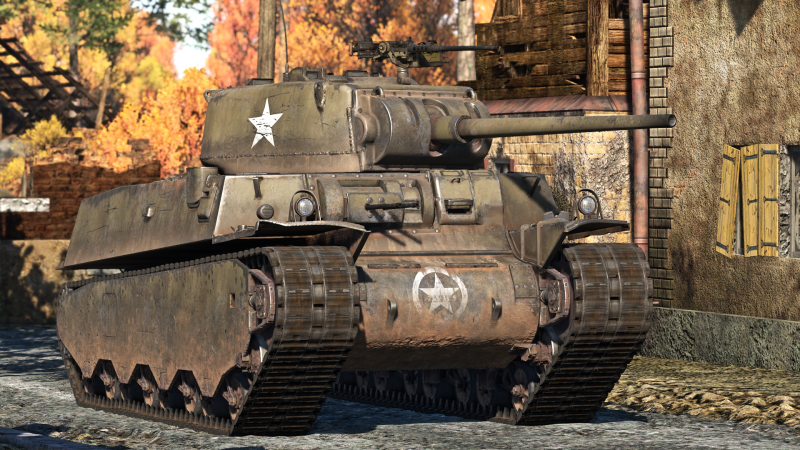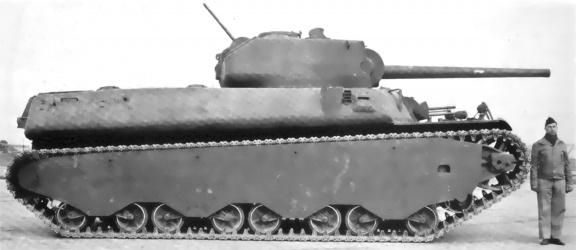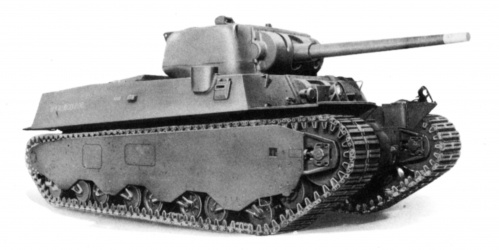M6A1
| This page is about the American heavy tank M6A1. For other versions, see M6 Heavy (Family). |
Contents
Description
In response to World War II breaking out across the Atlantic, the US decided to develop a new 50-ton heavy tank for their army, designated as T1. The design utilized a turret that held two cannons, a 3-inch tank gun and a 37 mm gun mounted side-by-side. Further development on the type of transmission to use with the heavy tank culminated with the T1E2 cast construction variant that utilized a torque converter transmission design was selected for standardization as the M6 heavy tank, with a second variant T1E3 with the same transmission that was constructed by welding was selected as the 'M6A1. A total of 40 tanks from the M6 family were assembled, 12 of which were the M6A1 variant. However, by the time these heavy tanks were ready for mass production, the U.S. Army had lost interest in them, considering the M4 Sherman as a better solution in terms of reliability and cost-effectiveness.
Introduced with the release of the American ground tree in Update 1.45 "Steel Generals", the M6A1 is a pretty unique tank in the US tech tree due to the dual-armament configuration in the turret. The tank has two 12.7 mm MGs in the hull which are effective for taking out lightly armoured vehicles such SPAAs. It is a large tank, but can be quite mobile due to the use of a powerful Wright G-200 engine (the same engine powering the B-17 Flying Fortress bomber) to propel it through a battlefield. Despite its in-game role as a heavy tank, the large size, mediocre mobility, and questionable armour for a heavy tank makes the M6A1 more well suited for second-line combat roles. Additionally, its slow reverse speed limits its ability to quickly retreat to cover when necessary.
General info
Survivability and armour
Armour type:
- Cast homogeneous armour (Front, Transmission area, Turret)
- Rolled homogeneous armour (Front, Side, Rear, Roof)
| Armour | Front (Slope angle) | Sides | Rear | Roof |
|---|---|---|---|---|
| Hull | 82.5 mm (5-35°) Front 101.6 mm (5-35°) Transmission |
44.4 mm | 41.4 mm | 25.4 mm |
| Turret | 101.6 mm (5-65°) Turret front 50.8 + 50.8 mm (5-65°) Gun mantlet |
82.5 mm (0-12°) | 82.5 mm (0-68°) | 25.4 mm |
| Cupola | 82.5 mm | 82.5 mm | 82.5 mm | 25.4 mm |
Notes:
- Suspension wheels are 15 mm thick while tracks are 17 mm thick.
- Frontal armour plate is unevenly curved for better ricochet chances and efficient armour thickness.
- Side skirts are 25 mm thick rolled homogeneous armour and will trigger fuses on APHE projectiles. In most cases, APHE shells set off before reaching the main hull and destroying the ammo stack beneath. Still, both skirts and hull are not sturdy enough to withstand a regular AP shell.
Mobility
| Game Mode | Max Speed (km/h) | Weight (tons) | Engine power (horsepower) | Power-to-weight ratio (hp/ton) | |||
|---|---|---|---|---|---|---|---|
| Forward | Reverse | Stock | Upgraded | Stock | Upgraded | ||
| Arcade | Expression error: Unexpected * operator. | 1,033 | Expression error: Unexpected round operator. | __.__ | |||
| Realistic | 708 | Expression error: Unexpected round operator. | __.__ | ||||
Modifications and economy
Armaments
Main armament
| 76 mm M7 | Turret rotation speed (°/s) | Reloading rate (seconds) | |||||||||||
|---|---|---|---|---|---|---|---|---|---|---|---|---|---|
| Mode | Capacity | Vertical | Horizontal | Stabilizer | Stock | Upgraded | Full | Expert | Aced | Stock | Full | Expert | Aced |
| Arcade | 75 | -10°/+30° | ±180° | Vertical | 14.57 | 20.16 | 24.48 | 27.07 | 28.80 | 7.67 | 6.79 | 6.25 | 5.90 |
| Realistic | 10.71 | 12.60 | 15.30 | 16.92 | 18.00 | ||||||||
Ammunition
| Penetration statistics | |||||||
|---|---|---|---|---|---|---|---|
| Ammunition | Type of warhead |
Penetration @ 0° Angle of Attack (mm) | |||||
| 10 m | 100 m | 500 m | 1,000 m | 1,500 m | 2,000 m | ||
| M62 shell | APCBC | 149 | 146 | 133 | 119 | 106 | 94 |
| M42A1 shell | HE | 17 | 16 | 15 | 13 | 12 | 10 |
| M79 shot | AP | 134 | 132 | 121 | 109 | 99 | 89 |
| Shell details | ||||||||||||
|---|---|---|---|---|---|---|---|---|---|---|---|---|
| Ammunition | Type of warhead |
Velocity (m/s) |
Projectile mass (kg) |
Fuse delay (m) |
Fuse sensitivity (mm) |
Explosive mass (TNT equivalent) (g) |
Ricochet | |||||
| 0% | 50% | 100% | ||||||||||
| M62 shell | APCBC | 792 | 7 | 1.2 | 14 | 63.7 | 48° | 63° | 71° | |||
| M42A1 shell | HE | 853 | 5.84 | 0.2 | 0.1 | 390 | 79° | 80° | 81° | |||
| M79 shot | AP | 792 | 6.8 | - | - | - | 47° | 60° | 65° | |||
Ammo racks
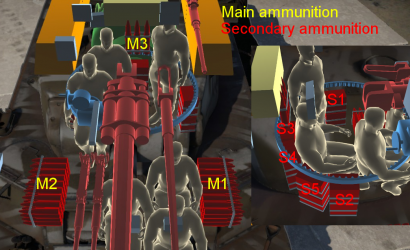
| Full ammo |
1st rack empty |
2nd rack empty |
3rd rack empty |
Visual discrepancy |
|---|---|---|---|---|
| 75 | 49 (+36) | 4 (+71) | 1 (+74) | No |
Note:
- As they are modelled by sets of 3 or 4, shells disappear from the rack once you've fired all shells in the set.
Additional armament
| 37 mm M3 | Reloading rate (seconds) | ||||||
|---|---|---|---|---|---|---|---|
| Capacity | Vertical | Horizontal | Stabilizer | Stock | Full | Expert | Aced |
| 202 | N/A | N/A | Vertical | 3.77 | 3.33 | 3.07 | 2.90 |
Ammunition
| Penetration statistics | |||||||
|---|---|---|---|---|---|---|---|
| Ammunition | Type of warhead |
Penetration @ 0° Angle of Attack (mm) | |||||
| 10 m | 100 m | 500 m | 1,000 m | 1,500 m | 2,000 m | ||
| M74B1 | AP | 79 | 76 | 65 | 54 | 45 | 37 |
| M63 shell | SAPHEI | 32 | 31 | 26 | 21 | 16 | 13 |
| M51B1 | APCBC | 87 | 84 | 73 | 60 | 50 | 41 |
| Shell details | ||||||||||||
|---|---|---|---|---|---|---|---|---|---|---|---|---|
| Ammunition | Type of warhead |
Velocity (m/s) |
Projectile mass (kg) |
Fuse delay (m) |
Fuse sensitivity (mm) |
Explosive mass (TNT equivalent) (g) |
Ricochet | |||||
| 0% | 50% | 100% | ||||||||||
| M74B1 | AP | 883 | 0.87 | - | - | - | 47° | 60° | 65° | |||
| M63 shell | SAPHEI | 792 | 0.73 | 1.2 | 9 | 38 | 79° | 80° | 81° | |||
| M51B1 | APCBC | 883 | 0.87 | - | - | - | 48° | 63° | 71° | |||
Ammo racks

| Full ammo |
1st rack empty |
2nd rack empty |
3rd rack empty |
4th rack empty |
5th rack empty |
Visual discrepancy |
|---|---|---|---|---|---|---|
| 202 | 160 (+42) | 120 (+82) | 80 (+122) | 40 (+162) | 1 (+201) | No |
Notes:
- Ammunition is modelled as 5 boxes of 40 or 41 shells.
- Boxes disappear once you've fired all shells in the rack.
Machine guns
| 12.7 mm M2HB | ||||
|---|---|---|---|---|
| Mount | Capacity (Belt) | Fire rate | Vertical | Horizontal |
| Pintle | 1,000 (200) | 577 | -10°/+50° | ±120° |
| Hull | 3,000 (200) | 577 | -10°/+35° | ±15° |
| Hull | 3,000 (200) | 577 | -10°/+35° | ±15° |
Usage in battles
Although this is a heavy tank, and able to bounce some shells, its armour will not protect it from all incoming fire. Enemies to specifically watch out for are the IS-1, Panthers, Tigers, and M4A3E2 Shermans, as they can all easily penetrate this vehicle's weak frontal armour. Make sure to protect the rear flank too: M6A1's engine is very large and prone to catching on fire when hit.
But despite the imperfect armour layout, the M6A1 does bring an impressive cannon to the battle. The powerful 76 mm gun is able to penetrate the front of most Rank III tanks and can destroy most enemy targets in a single shot. The secondary cannon is weaker than the 76 mm, but can be effective. When engaging targets from the side, this smaller gun should have no trouble penetrating and destroying an enemy unit. And as with all multi-gun tanks, the secondary gun should be fired separately from the main cannon to maximize efficiency and facilitate aim. By firing the secondary cannon, it is occasionally possible to bait the enemy into advancing out of cover and revealing a weak spot. They will not expect that you have another shell loaded in the main gun. Additionally, the vehicle mounts three 12.7 mm machine guns, which can be very effective in dealing with enemy aircraft if positioned correctly.
In most situations, the M6A1 driver will find that a slower play-style suits this tank best. The vehicle is large, turret rotation is slow, and enemies will be eager to flank it. As such, the support of teammates is necessary for an effective attack. In a defensive situation, the M6A1 is effective when located behind a ridge or other cover. This will help to obscure the tank's large profile and allow the player to ambush advancing enemies.
The M6A1 is often compared to the M4A3E2 Jumbo Sherman. Although less armoured than its higher-tiered counterpart, the M6A1 is arguably better than the Jumbo during the early game and at range. While the M4A3E2 may have trouble dealing with enemy heavy tanks such as the KV-1, this vehicle is very-well suited for engaging those targets. The M6A1 may be thought of as a Jumbo Sherman that was traded some of its armour protection in exchange for a more lethal armament.
Pros and cons
Pros:
- Great main 76 mm gun and ammunition capable of knocking out tanks with a single shot
- Great secondary 37 mm gun with good reload speed and decent penetration
- Good gun depression
- Has .50 cal AA machine gun, as well as a dual-mount .50 cal in front
- First standard heavy tank in the US tree, which can dish out and take punishment equally
- Lower portion of the hull sides are protected by additional 25.4 mm armour sheet
- Adequate roof armour of 25 mm means aerial strafing will be of a little issue without large-calibre weaponry
- Rear mounted transmission means it is not affected with a frontal penetration
- Big hull increases the chance of surviving after a penetrating hit
- Good acceleration and power-to-weight ratio
- Good hill-climbing abilities
- Very good cross country performance due to large tracks
Cons:
- Lots of weak points, such as gun mantlet, upper side armour, driver port, MG port, and front armour cheeks
- Armour profile overall is quite flat, no angling benefits
- Ammo is stored in the lower side armour
- All automotive module mounted in the rear, easily prone to damage, set ablaze, or exploded when shot
- Slow top speed
- Mediocre turn speed
- Pretty large in general, will stand out in the battlefield
History
Development
When World War II broke out, limited development in the United States meant that the military possessed very few tanks and so development hastened and eventually gave them tanks such as the M3 Lee and M4 Sherman. On May 20, 1940, the US Army Ordnance Corps began to work on a 50-ton heavy tank for their army. Initially, it was going to have a multi-turret design, two turrets with the 75 mm gun and one secondary turret with a 37 mm gun with a coaxial machine gun, then one more with a 20 mm gun with coaxial. Plus, four .30 cal machine guns were to be put on ball mounts on the front glacis and rear corners of the hull. This project was approved on June 11, 1940, and moved on as the Heavy Tank T1. However at the same time, similar concepts in Europe of heavy breakthrough tanks such as the Soviet T-35 and the German Neubaufahrzeug tanks were falling out of favour due to lack of combat effectiveness and unfavourable performance for their cost, and the US did the same in October so the design was changed.
The tank now had one turret with a 3-inch (76.2 mm) gun alongside a coaxial 37 mm gun. The turret housed three crew members and was powered by an electrical traverse system. The commander's cupola was copied from the M3 Lee, featuring a hatch with it sown machine gun. Two .50 cal machine guns now protruded from the bow mount (fired by bow gunner) and two .30 cal machine guns as well (fired by the driver). The entire tank held six crew members, the commander, gunner, driver, assistant driver, loader #1, and loader #2. While the construction of the vehicle was feasible, the engine was not enough to power the vehicle reliably due to heavy 57-ton weight.
In 1941 to 1942, three prototypes were constructed with the different transmission, one with electrical and the rest with a torque converter. The ones with the torque converters were designated the Heavy Tank M6 and M6A1, with the M6A1 differing from a welded hull construction. The electrical transmission design, designated M6A2, was never approved by Ordnance, but was to be manufactured anyway. It was hoped that 115 of these tanks could be built for further testing and production started in December 1942 with design changes. The commander's cupola now featured a regular hatch rather than the machine gun one, which was removed along with one of the machine gun in the front hull. By the time the M6 was ready for production, the Army was moving forward and interest waned on these heavy tanks with the M4 Sherman's performance in the war. The M6's armour was only slightly thicker than the Sherman's and the 3-inch gun didn't offer too much improvement over the 75 mm gun, plus it had a large profile and low ergonomics, not to mention mechanical issues.
Production and cancellation
In early 1942, the M6 production was set for 250 a month but was cut down in September from 5,000 to a mere 100 when manufacturing focus moved to planes. By the end of 1942, Sherman's performance in the war proved its role in the war was more adaptable than the M6 heavy tank while remaining cheaper and lighter for transportation and supplying. This caused the M6 production to lower even more to just 40, before being shut down. Though testing with a 90 mm gun found the M6 to be a good gun mount, the poor layout of the tank restricted it, and the project was shut down before further development could be made.
In August 1944, the Ordnance Corps planned to modify some of the M6 heavy tanks with more armour and heavier armament to breach fortified areas. These were to be the M6A2E1 and weighed 77 tons with a 190 mm front armour and a 105 mm gun. Eisenhower rejected these as impractical and cancelled it. The M6 was found to be obsolete by December 1944 with only 40 units produced and never seeing combat service. They served as a propaganda piece during the war and were all scrapped after it except one, which is put on display at Aberdeen, Maryland at the United States Army Ordnance Museum. During development, the M6 turret was modified to become the turret for the M10 Tank Destroyer.
| Archive of the in-game description | |
|---|---|
|
At the end of May 1940 the US infantry chief of staff responsible for armour put together requirements for future tanks in light of what was happening in Europe: the German army was relentlessly moving toward France and using armour with great success along the way. The Wehrmacht's use of new Pz.IV tanks with 75 mm guns instantaneously made the American tanks and their 37 mm cannons obsolete. The new tank type had to be heavy (around 50 short tons), with 76 mm and 37 mm cannons arranged side-by-side in the turret. It had four machine guns (two heavy-calibre and two rifle-calibre), a Wright G-200 engine, a Hydromatic transmission, and a top speed of 25 mph. The green light was given for the construction of four prototypes in February 1941. The prototypes developed by the Baldwin Locomotive Works were designed with different transmissions and hulls in the interests of finding the best option for full-scale production. Two modifications at most were permitted, and on April 13, 1942, the T1E2 and T1E3 were standardized as the M6 and M6A1. The latter added a welded hull, Wright G-200 engine, and torque converter to the M6. Mass production was scheduled for November 1942, though a report by General Jacob Devers on December 7 indicated that the M6s would enjoy only limited tactical use due to their size. Moreover, two M4s equipped with 75 mm and 76 mm weapons could be built in place of two heavy tanks. As a result, the Armored Corps hurried to revoke the contract. Between 1942 and 1943 the Baldwin Locomotive Works ended up producing 12 M6 heavy tanks. They did not join the army or see combat. | |
Media
- Skins
- Videos
See also
- Related development
- T1E1 / M6A2 - Earlier prototype for the M6 Heavy tank program with experimental electrical transmission
- M6A2E1 - Upgunned and uparmoured T1E1
External links
| USA heavy tanks | |
|---|---|
| M4 Jumbo | M4A3E2 · Cobra King · M4A3E2 (76) W |
| M6 | M6A1 · T1E1 · T1E1 (90) · M6A2E1 |
| T26 | T26E1-1 · T26E5 |
| T29/30/34 | T29 · T30 · T34 |
| T32 | T32 · T32E1 |
| M103 | M103 |
| Others | T14 |



